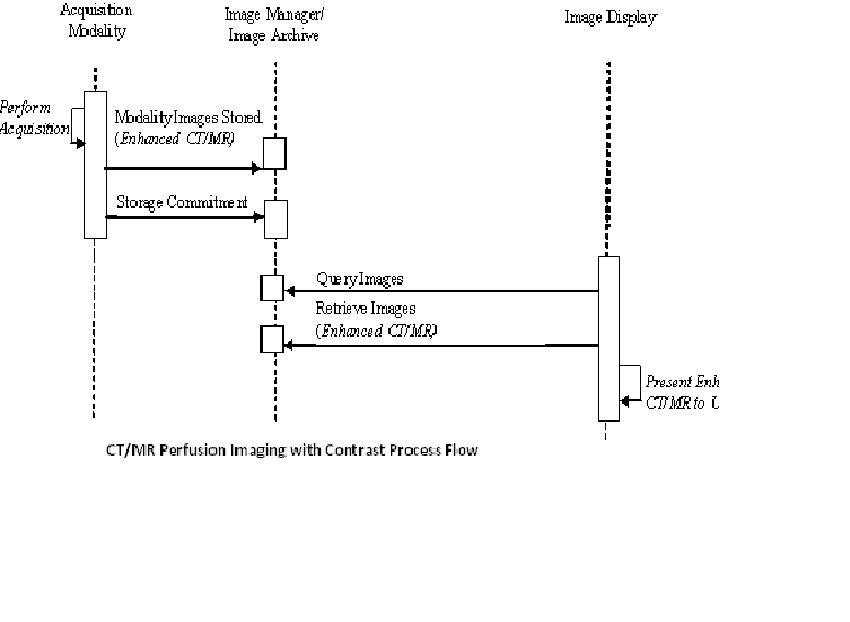CT/MR Perfusion Imaging
CT/MR Perfusion with Contrast (PERF) facilitates the exchange of contrast enhanced images containing standard attributes for timing and position.
Summary
The CT/MR Perfusion Imaging with Contrast Integration Profile facilitates the exchange of contrast enhanced images containing standard attributes for timing and position. The exchange of these attributes allows for correct and convenient display. This profile creates a stack of images at different timeslots, in order to display the contrast agent over time. The images need to be stored with indices along their position in the stack and the progress of time. Additional functional and data requirements are defined for the Modality Image Creator and Image Display actors, which allow for correct and convenient display of the Perfusion with Contrast.

Benefits
Defines the correct and convenient display of the Perfusion with Contrast
- Creates stacks of images at different timeslots, in order to demonstrate the uptake of a contrast agent over time.
- Defines how the perfusion images are stored and archived into frames of one Enhanced DICOM (Multi-frame) object so that they can later be retrieved and displayed in an unambiguous way on image viewers supporting Enhanced DICOM objects
Improves the Consistency and Interoperability of the Perfusion Display with Contrast, clinical applications
- Provides standard attributes for “timing” and “position” information for the Workstation being capable of Display consistently and Interoperable
- Reduce implementations diversity of choices for improving interoperability
Enables widespread and adequate review and interpretation of contrast-enhanced frames by radiologists in an IT environment where all Actors support the Enhanced CT or Enhanced MR DICOM objects
Improves the acceptance of the Enhanced SOP Classes by industry and users
Reduces Deployment Cost/Time
Details
The CT/MR Perfusion Imaging with Contrast (PERF) Integration Profile:
- Facilitates the exchange of contrast enhanced images containing standard attributes for timing and position
- Defines how the perfusion images are stored and archived into frames of one Enhanced DICOM (Multi-frame) object so that they can later be retrieved and displayed in an unambiguous way on image viewers supporting Enhanced DICOM objects.
- The images need to be stored with indices along their position in the stack and the progress of time.
- A stack of images is being created at different timeslots, in order to display the contrast agent over time
- Defines the correct and convenient display of the Perfusion with Contrast
- Requirements for the Perfusion Creator modality are:
1. Create an Enhanced CT or MR SOP Instance 2. Modality provides Dimension indices: Stack ID, In Stack Position Number, Temporal Position Index 3. Data requirements: Image Type and frame Type should be: Value 1: ORIGINAL, Valuem 2: PRIMARY, Value 3: PERFUSION
- Requirements for Image Display Perfusion with contrast:
1. Provide at least one viewport for display of frames with the same In-Stack Position Number (Slice-index). More viewports may be used for displaying images for other In-Stack Position Numbers= simultaneous scrolling 2. Scroll the images by Temporal Position Index: phase-index = time related movie 3. Provide the time since the start, deducted from Frame Reference DateTime 4. Display the values of the dimension attributes and contrast attributes. 5. Display Frame annotations for Frame Number, Slice offset, relative time.

Systems Affected
Systems involved in this profile are:
- Image Display that displays the viewports of frames with the identical In-Stack Position Number (Slice Ingdex)
- Radiology image manager/archive, Storing the images with indices along their position in the stack and the progress of time.
- Acquisition modalities, creates the Enhanced CR or MR SOP instances with the appropirate dimension indices
Actors & Transactions:
Specification
Profile Status: Final Text
Documents: IHE Radiology Technical Framework:
Underlying Standards:
See Also
Related Profiles
- Patient Information Reconciliation [PIR] extends the capability of SWF by handling cases of unidentified (e.g. trauma), or misidentified patients.
- Cardiac Cath Workflow [CATH] - uses many of the mechanisms of SWF to integrate ordering, scheduling, imaging acquisition, storage and viewing for Cardiac Catheterization procedures.
- Echocardiography Workflow [ECHO] - uses many of the mechanisms of SWF to integrate ordering, scheduling, imaging acquisition, storage and viewing for digital echocardiography
- There are a a number of "content profiles" describing the details of creating and storing various types of image or image related objects, and frequently they would be created in the context of SWF. These content profiles include:
- Nuclear Medicine Image [NM] specifies how Nuclear Medicine images and result screens are created, exchanged, used and displayed.
- Mammography Image [MAMMO] specifies how Mammography images and evidence objects are created, exchanged, used and displayed.
- Evidence Documents [ED] specifies how data objects such as digital measurements are created, exchanged, and used.
- Key Image Note [KIN] lets users flag images as significant (e.g. for referring, for surgery, etc.) and add notes.
Consumer Information
The Scheduled Workflow FAQ answers typical questions about what the Profile does.
Scheduled Workflow Purchasing describes considerations when purchasing equipment to deploy this Profile.
Implementer Information
Scheduled Workflow Implementation provides additional information about implementing this Profile in software.
Reference Articles
- Using the IHE Scheduled Work Flow Integration Profile to Drive Modality Efficiency, Moore, Stephen M., 2003, Radiographics, Vol. 23, pp 523-529
- Considerations for Setting Up an Order Entry System for Nuclear Medicine Tests, Hara, Narihiro, et al., Journal of Nuclear Medicine Technology, 2007, Vol. 35, Num. 4, pp 259-271
- IHE technical framework and its application (Article in Chinese), Feng JY, et al., Chinese Journal of Medical Instrumentation, 2005, May, Vol. 29, Num. 3, pp. 199-201
This page is based on the Profile Template